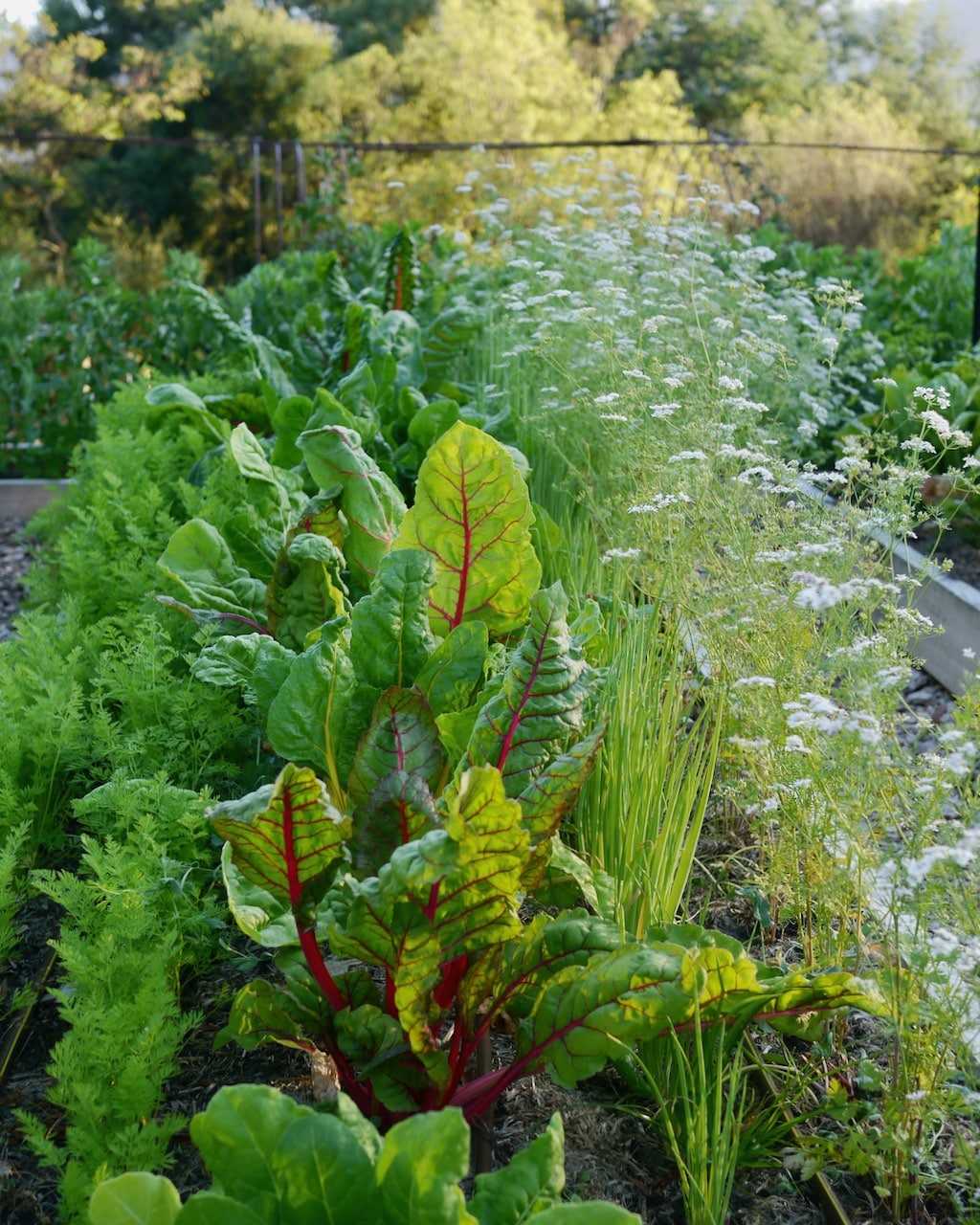
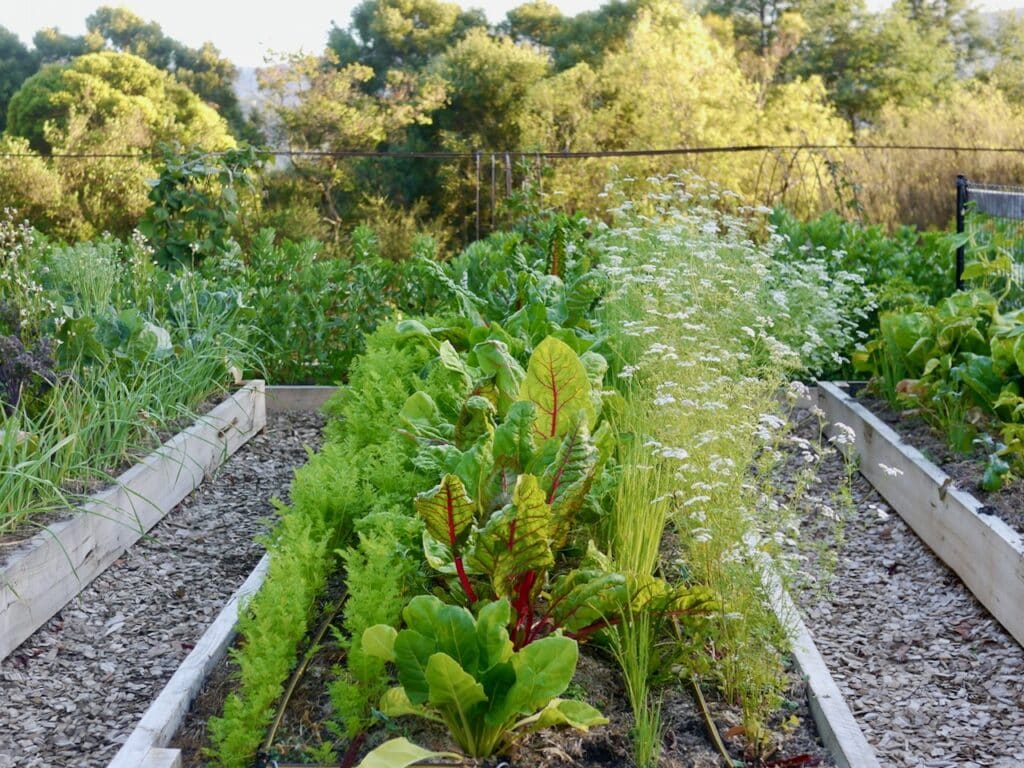
Companion planting isn’t about strict rules – it’s about principles, observation, and learning from your garden – it’s about understanding how different plants can work together, creating a garden that is more resilient, productive, and a joy to tend.
Carrots, silverbeet, and flowering coriander doing their companionable thing in our garden is a perfect example of how some plants tend to naturally support each other.
Whether it’s one plant providing shade for another, fixing nitrogen in the soil, or attracting beneficial insects, these relationships strengthen our backyard ecosystems.
By understanding how different plants can work together, we can create gardens that are even more resilient, productive, and a pleasure to tend. And figuring out which plants benefit each other is a part of this, that even beginner gardens can happily learn!
Companion planting is something that we get asked about a lot…
…by our students, and there’s many opinions (and experiences) on what works and what doesn’t, in different contexts!
I used to love our companion gardening books, but nowadays I see the whole ‘who to plant next to whom’ from a different angle…
Instead of just using lists, observation and experimentation is invaluable to guide you toward the combinations of veggies that will thrive nearby each other, in your garden context.
As you plant, take note of what works, adapt with the seasons, and let your garden evolve into a dynamic, self-reliant system where plants, soil, and pollinators all play their part.
So firstly – may I suggest that companion planting, particularly with annual vegetables, is at its most basic about identifying which different plants have complementary needs, and outputs.
Different plants that like the same amount of fertility and watering, at the same time of year, could be a good match if you need to huddle multiple crops into one garden bed.
Or it might be that one crop provides shade, while the next crop is young and needs protection, and their roots won’t interfere much with each other (carrots and radishes, I’m looking at you).
There’s a million other combinations and examples of annual veg being good friends with each other. Plus there’s all the microbial relationships happening in the soil food web below your vegetables – all the microbes and fungi and everyone else in there, which all contribute to how well different plants grow.
So yes, companion planting IS a way to embrace the interconnectedness of plants, insects, and soil.
And some of the knowledges that we have now have, do come from both traditional wisdoms and modern ecological science.
However – it’s often as much about shared or opposing needs and functions as it is about ‘this plant doesn’t like that plant’… so don’t worry – you’re very unlikely to kill your tomatoes if you plant them next to something that some companion planting guide somewhere said they were not compatible with.
That said, there’s some vegetables that just love growing together, and always do really well when planted side-by-side. So when you see this happen in your garden, make a note.
Over time, you can create your own companion planting chart for what grows well, and with whom, where you live.
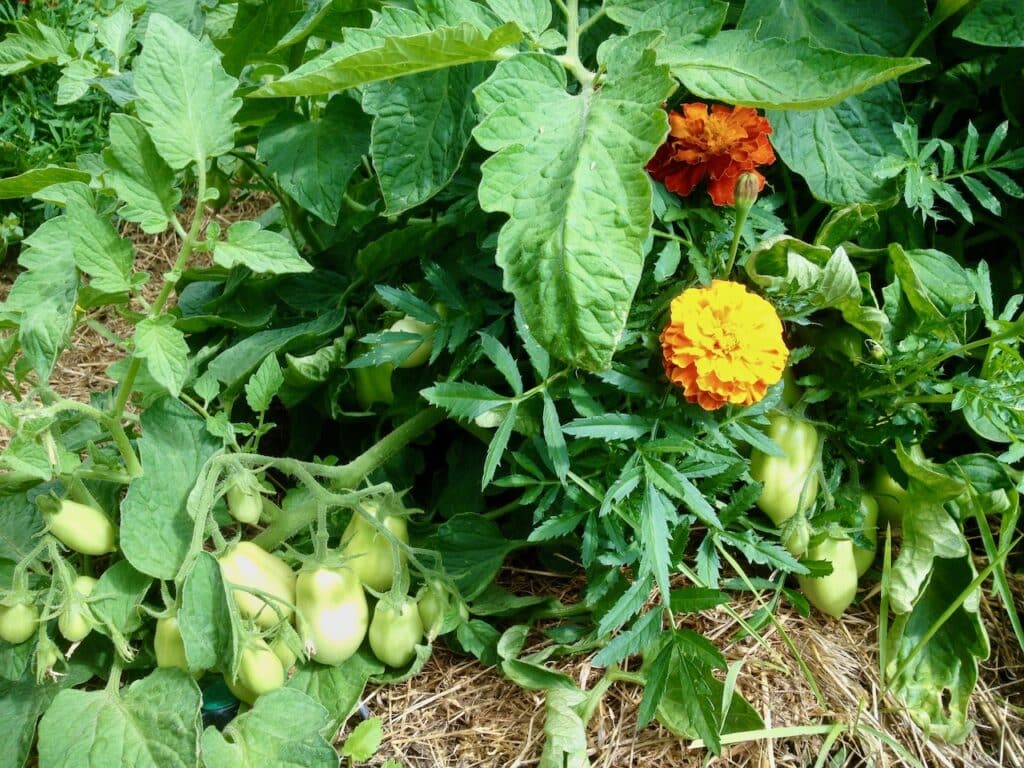
Companion planting is about designing, observing, learning and then co-evolving a system of plantings that work with your ecosystem, where you are.
Instead of rigid lists dictating what grows best with what, much of this can be worked out by observing and experimenting.
Take fertilising, for instance—many plants, like peas, beans, lupins, and clover, fix nitrogen from the air and enrich the soil. Their spent foliage can be used to fertilise neighboring plants, especially if cut down before they divert energy into seed production.
Work with your ecosystem! And Observe and Interact…
Companion planting is about more than just arranging plants, though—it’s also about working with nature to suppress weeds and manage pests.
Plants like radishes and brassicas, left to flower and seed, can naturally inhibit weed growth while conditioning the soil for the next crop. Marigolds form a natural barrier against invasive grasses, and comfrey keeps out persistent kikuyu while doubling as a fantastic mulch.
Even pests can be controlled by encouraging their natural predators—birds, beneficial insects, and tiny predatory wasps all thrive in gardens filled with year-round flowering plants. So make sure you have plenty of those.
By mixing up plantings, creating natural camouflage, and maintaining a diverse garden ecosystem, pests get confused, weeds get suppressed, and predators do the heavy lifting, leaving you free to enjoy a bountiful and balanced garden.
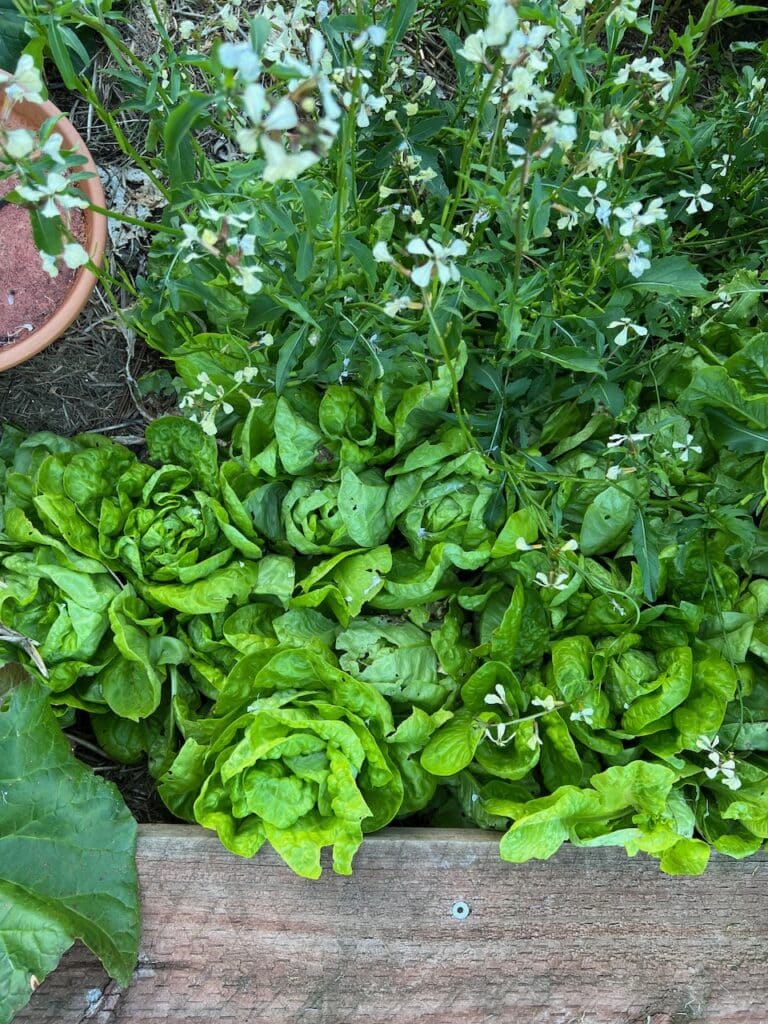
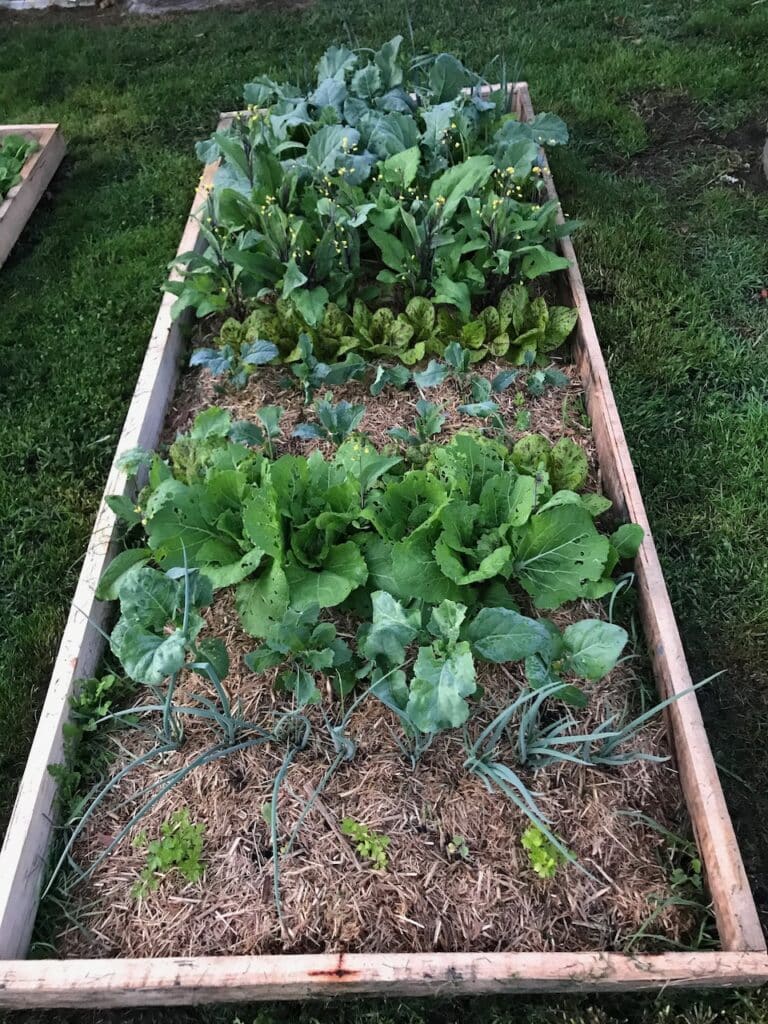
The Basics of Companion Planting
Collaboration is Key
At its core, companion planting is about creating diverse ecosystems. Plants don’t exist in isolation, just like us! They thrive in communities, each species playing its part. Here’s how they do it:
- Pest Management: Some plants are natural bodyguards, releasing chemicals or scents that pests just can’t stand. Take marigolds, for instance—they’re like bouncers for nematodes. And garlic? They’re an aphid’s worst nightmare.
- Inviting the Good Bugs: Want more bees, butterflies, and ladybugs? Certain flowers, like yarrow and dill, are the ultimate hosts for these beneficial insects, helping keep harmful pests in check.
- Boosting the Soil: Legumes like beans and peas are like tiny, hardworking factories. They fix nitrogen into the soil, enriching it for their neighbours.
- Weed Warriors: Ground-cover plants such as sweet alyssum are nature’s weed-blocking mulch, growing quickly to outcompete unwanted intruders.
- Microclimate Magic: Tall plants, like sunflowers or corn, create shade and shelter for their more delicate companions, offering a buffer against the elements.
- Sacrificial Heroes: Some plants take one for the team, attracting pests away from your main crops. Nasturtiums can be a perfect example, drawing aphids and cabbage moth grubs away from your veggies.

Learning from Traditional Knowledge
The roots of complementary plant pairings and groupings run deep. One great example of this is the “Three Sisters” planting method that comes to us from Turtle Island cultures – Maize corn providing a living trellis for beans, the beans enriching the soil, and squash or pumpkins covering the ground to retain moisture and suppress weeds. Yay for reciprocity.
Many studies now back these principles up – diverse plantings can lower pest populations, improve soil health, and even boost yields. And, whether you’re growing in a backyard or on a balcony, these principles hold true.
Companion Planting Chart
Here’s a little starter chart to guide you…. although, again, you can’t beat your own powers of observation and experimentation, especially as every garden is different!
However, given that there’s many companion planting books that repeat not-quite-truisms, we’ve included below what we’ve seen work in a range of climates, and plant combos that generally do well in proximity to each other.
| Primary Crop | Companion Plants | Benefits |
|---|---|---|
| Beetroot | Onion, Lettuce, Cabbage, Radish, Oregano, Bush Beans | Onions deter pests; bush beans fix nitrogen. |
| Broccoli | Celery, Onion, Basil, Chamomile, Nasturtium, Dill, Beets | Celery and basil repel cabbage moths; chamomile improves flavor. |
| Cabbage | Dill, Onion, Chamomile, Celery, Nasturtium, Thyme | Dill attracts wasps; onions deter cabbage moths; thyme repels pests. |
| Carrot | Onion, Leek, Rosemary, Chive, Sage, Nasturtium, Parsnip | Onions and leeks keep carrot flies at bay; nasturtiums repel aphids. |
| Corn | Beans, Squash, Melon, Sunflower, Nasturtium, Cucumber, Dill | Beans enrich the soil; dill attracts pollinators; cucurbits provide ground cover. |
| Cucumber | Radish, Nasturtium, Corn, Dill, Sunflower, Peas, Oregano | Radishes deter some beetles; peas enrich the soil; oregano repels some pests. |
| Eggplant | Beans, Marigold, Thyme, Spinach, Peas, Tarragon, | Marigolds deter nematodes; thyme repels some moths; peas enrich soil. |
| Herbs (General) | Basil, Dill, Chamomile, Thyme, Sage, Marjoram, Oregano | Mixed herbs repel pests, attract pollinators, and enhance nearby plants. |
| Lettuce | Carrot, Radish, Strawberry, Garlic, Chervil, Beetroot, Marigold | Carrots and radishes help break up soil; marigolds deter aphids and thrips. |
| Melon | Corn, Beans, Sunflower, Dill, Marigold, Lavender | Lavender repels moths; dill attracts pollinators. |
| Onion | Carrot, Lettuce, Beet, Strawberry, Chamomile, Summer Savoury, Sage | Carrots deter onion flies; summer savoury improves growth. |
| Pepper / Capsicum | Basil, Onion, Spinach, Marjoram, Nasturtium, Oregano, Petunia | Basil wards off some pests; petunias repel some aphids and beetles. |
| Potato | Beans, Marigold, Cabbage, Corn, Yarrow (non-invasive varieties) | Beans enrich the soil; yarrow attracts beneficial predators. |
| Radish | Lettuce, Carrot, Cucumber, Peas, Spinach, Marigold | Marigolds can deter nematodes. |
| Spinach | Peas, Radish, Strawberry, Beans, Calendula, Coriander, Dill | Peas enrich the soil; dill attracts beneficial insects; coriander repels aphids. |
| Squash | Corn, Beans, Radish, Borage, Tansy | Tansy deters squash bugs. |
| Tomato | Basil, Marigold, Carrot, Garlic, Lettuce, Borage, Parsley | Basil boosts flavour and deters flies; marigolds fend off nematodes; borage attracts pollinators; parsley enhances growth. |
| Zucchini | Borage, Marigold, Corn, Peas, Dill, Thyme | Borage attracts pollinators; thyme repels whiteflies. |
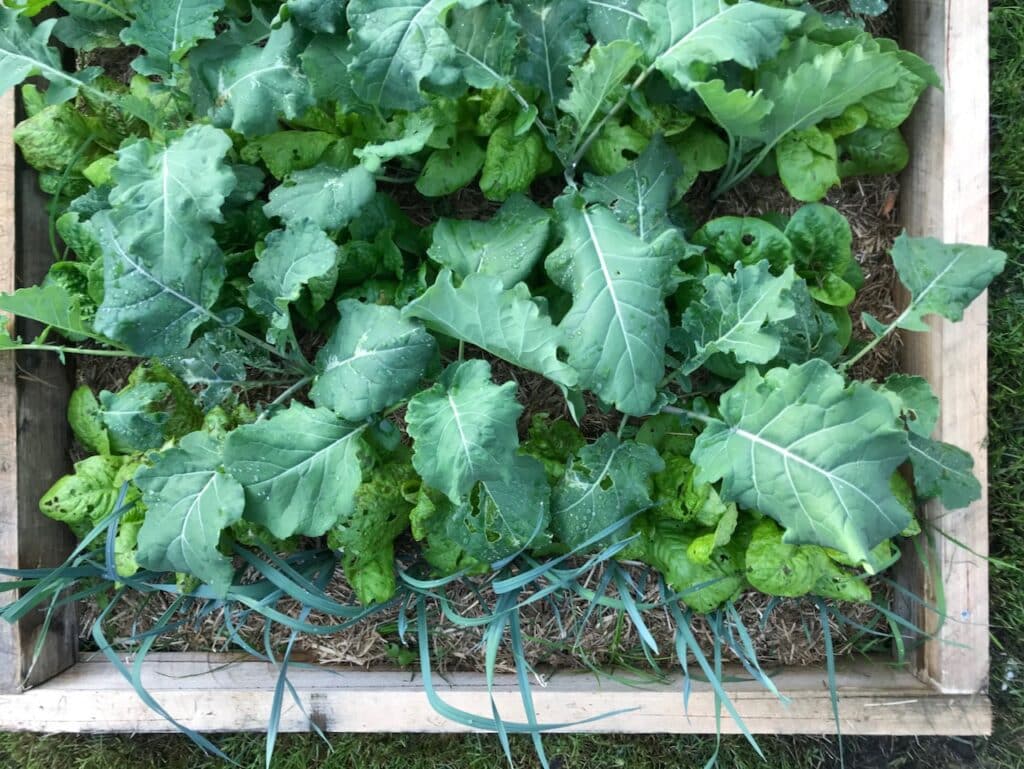
Companion planting isn’t just about ideal pairings…
It’s also about harnessing the hidden superpowers of certain plants that offer unique benefits to the whole garden ecosystem. Some of these plants can be planted as ‘trap crops’ borders or clumps of plants that draw pests away from other valuable harvests.
Some plants deter pests, while others enrich the soil, enhance compost, or even boost the yield of neighbouring crops. Here’s a collection of garden allies that can work their magic in unexpected ways:
- Basil – Not just a fragrant herb for the kitchen, basil is said to repel flies and mosquitoes, making it a perfect partner for outdoor seating areas and vegetable patches alike.
- Borage – If you’re growing strawberries, tuck some borage among the plants—it’s known to increase yields and bring in pollinators.
- Caraway – A deep-rooted wonder, caraway helps break down heavy soils, making it easier for neighbouring plants to thrive.
- Chives – A must-have under apple trees to help prevent apple scab, and beneath roses to ward off aphids and blackspot.
- French Marigold – The roots of these bright blooms secrete compounds that kill soil-dwelling nematodes, while the plant itself repels whiteflies in tomato beds.
- Garlic – A must-have in any garden, garlic is famous for keeping aphids off roses and warding off a host of other pests.
- Hyssop – An unexpected brassica protector, hyssop attracts cabbage white moths, luring them away from your crops.
- Nasturtium – A garden hero (in the right place, that is), nasturtiums attract pests like aphids and cabbage white moths away from your veggies while repelling cucumber beetles. Climbing varieties grown in apple trees help deter codling moth.
- Pyrethrum – A natural insect repellent, planting pyrethrum around the vegetable garden will keep unwanted bugs at bay.
- Rosemary – Protects carrots by repelling the notorious carrot fly and makes a fragrant addition to any kitchen garden.
- Sage – A brassica bodyguard, sage helps keep cabbage white moths from laying eggs on your precious cabbages.
These plants are just a few of the examples of plants helping each other (and you) out – and helping to build a more resilient, biodiverse, and low-maintenance garden in the process.
Whether you’re looking to deter pests, improve soil health, or simply create a healthier growing space, adding a few of these powerhouse plants can make a lot of difference.
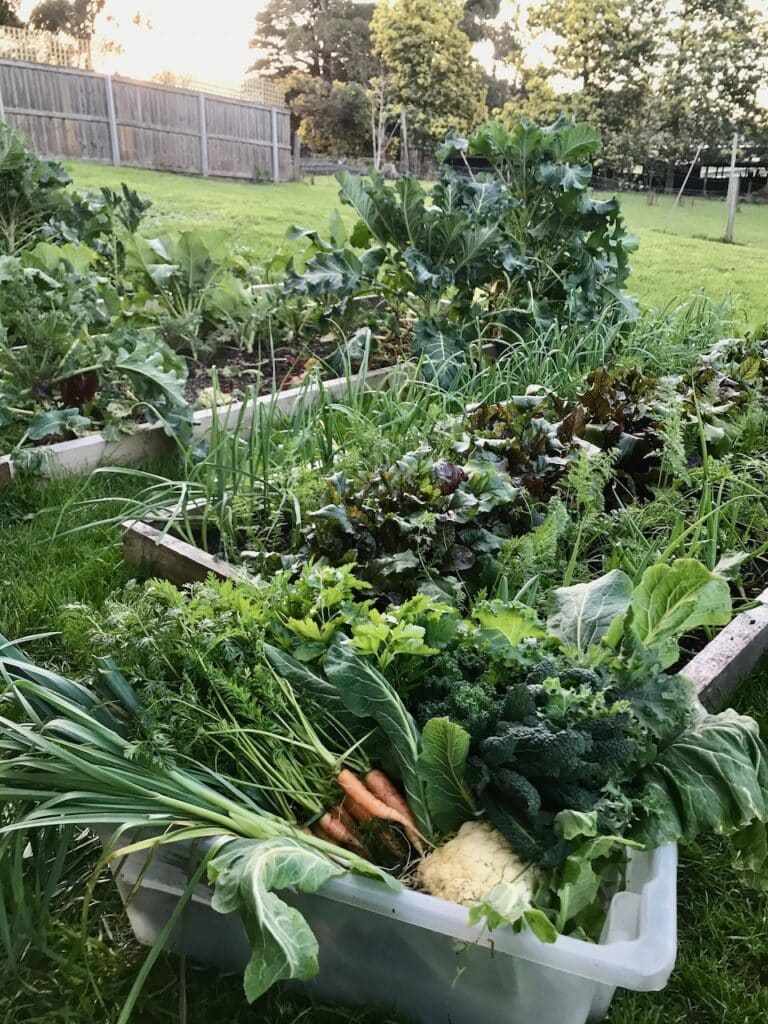
Crafting Your Companion Garden
Ok, that’s all great, but where do you start? Well, here’s a SUPER brief rundown…
Start with a Plan
- Sketch It Out: Begin with a simple map of your garden. Group plants based on their companions and consider their heights, root depths, and sun needs.
- Rotate Crops: Avoid planting the same families in the same spot year after year. Crop rotation breaks pest cycles and keeps soil healthy.
- Add Diversity: A mix of veggies, herbs, and flowers isn’t just pretty; it’s functional. Diversity attracts pollinators and deters pests.
- Succession Planting: Use your space wisely by planting quick growers like radishes between slower crops like cabbage or tomatoes.
Keep the Ecosystem Thriving
- Bring in the Helpers: Flowers like calendula, cosmos, and borage are magnets for pollinators and pest-predators.
- Feed the Soil: Mulch with organic matter and compost regularly. Healthy soil is the backbone of any successful garden.
- Observe and Adapt: Gardening is part art, part science. Watch how your plants grow together and tweak combinations as needed.
- Stay Organic: Avoid chemical pesticides. Encourage natural predators like ladybugs and lacewings to do the job instead.
Troubleshooting
- Overcrowding: Give plants room to breathe and grow. Good airflow prevents fungal issues.
- Companion Conflicts: Double-check pairings to avoid stunting or pest magnetism.
- Persistent Pests: If pests overwhelm, consider introducing new flowers or organic sprays as a backup.
So – companion planting can be a celebration of how plants, insects, and soil work together.
It’s about letting your emerging backyard ecosystem lead the way, and working with your garden to create a thriving, interconnected system. Start small, take notes, and experiment.
Ok, so you could start there – and that would be great.
However, if you also have perennials (like fruit trees) in your garden somewhere, and are looking for ways to ensure they thrive, let me introduce you to…
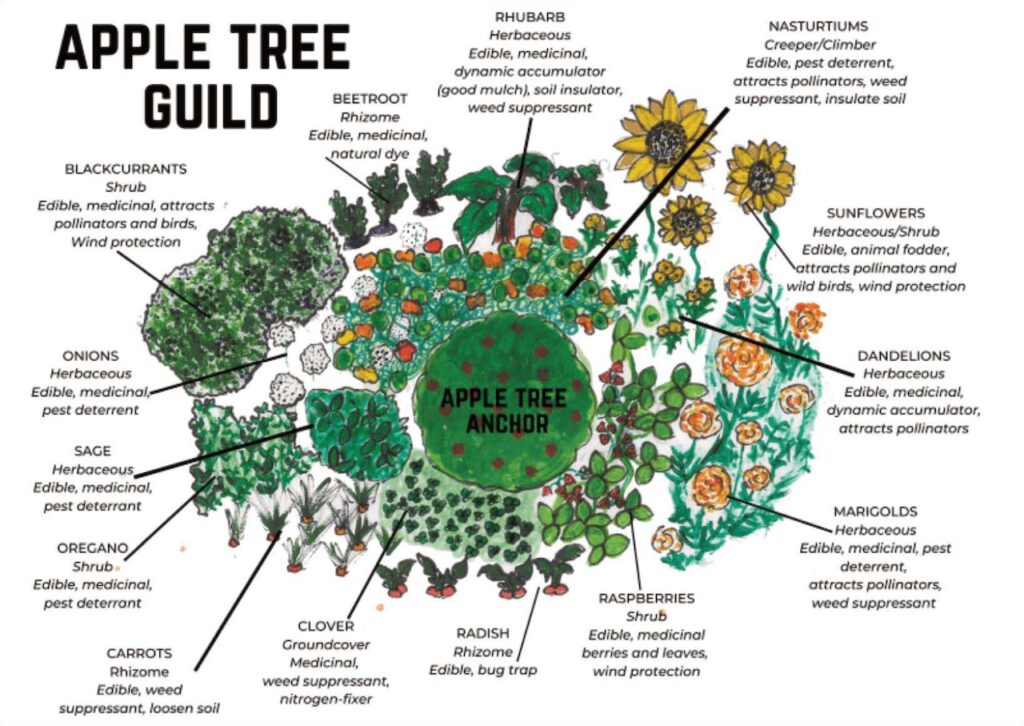
Guild Planting! As used in Polyculture Gardens, Forest Garden design, etc…
A guild planting, in permaculture terms, is usually used to define a harmonious assembly of species clustered around a central element (plant or animal) that acts in relation to this element to assist its health, aid our work in management, or buffer adverse environmental effects (Mollison, via Jacke).
Dave Jacke has taken this concept further and identifies a range of different types of guilds that generally (but not exclusively) can be applied to aid forest garden design process. Like many permaculture design elements, these guild types at once simple, and deeply complex…
>> read on about Forest Garden Guilds here…
And yes, you can use guild plantings in polyculture vegetable gardens, as well. There’s so many options! And so much to learn. A lifetime, even…
Whew! Wow, that’s a lot of info. Feel free to comment below if you have any questions, at this point…
And know that each season will bring new lessons, and every plant has a role to play. Happy planting, learning and working with your lil backyard ecosystem!
If you’d like to learn to create and maintain a veggie garden with friendly expert help, no matter where you live, please do check out our Beginner’s Guide to Veggie Gardening below…
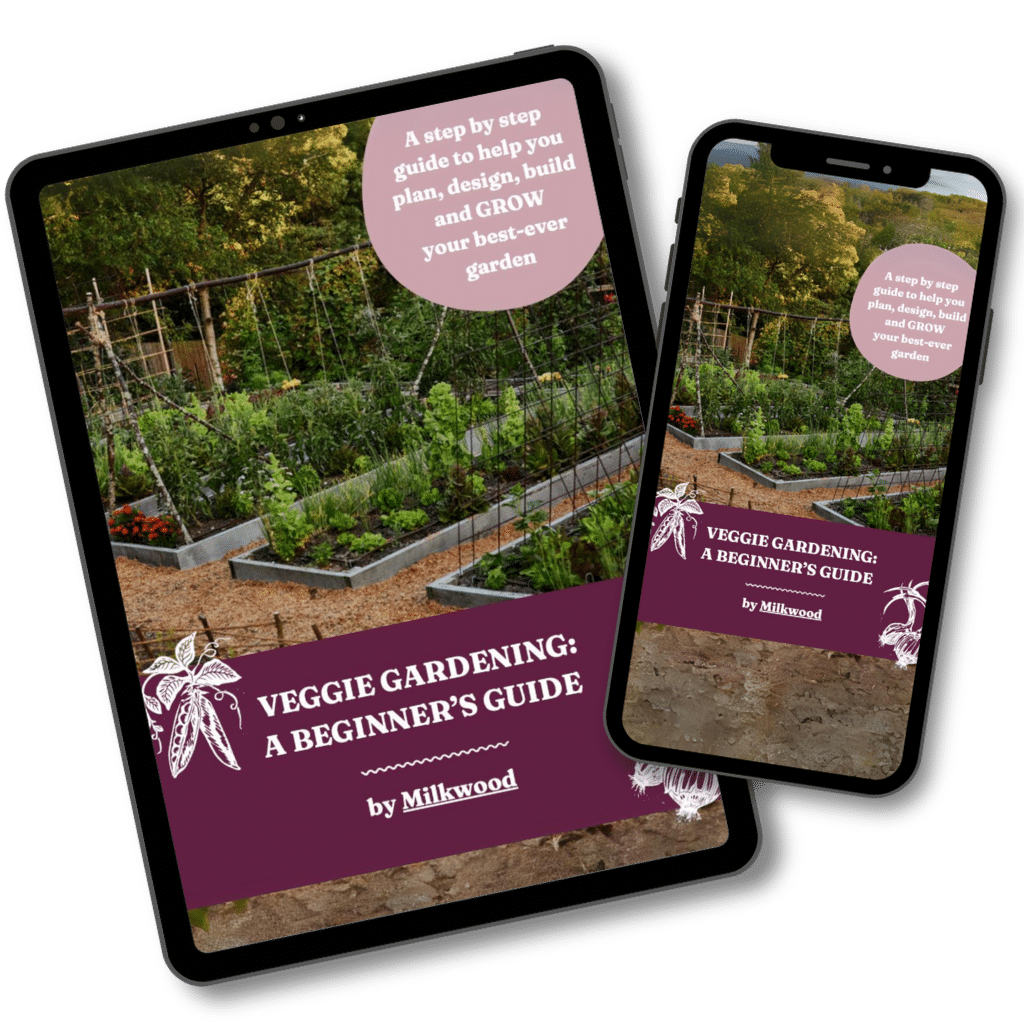
… and also our Organic Vegetable Gardening online course, which is a cracker.
Great resources on Companion planting:
- All our articles and free guides on Gardening
- Forest Garden Guilds – with Dave Jacke
- Companion Planting & Botanical Pesticides: Concepts & Resources – including ‘trap crops’ – and here in pdf form
- Companion planting in home gardens – Uni of Minnesota – great round up
- Companion Planting – Basic Concepts and Resources – pdf download
- Afristar Companion Planting poster! And lots of other goodness 🙂
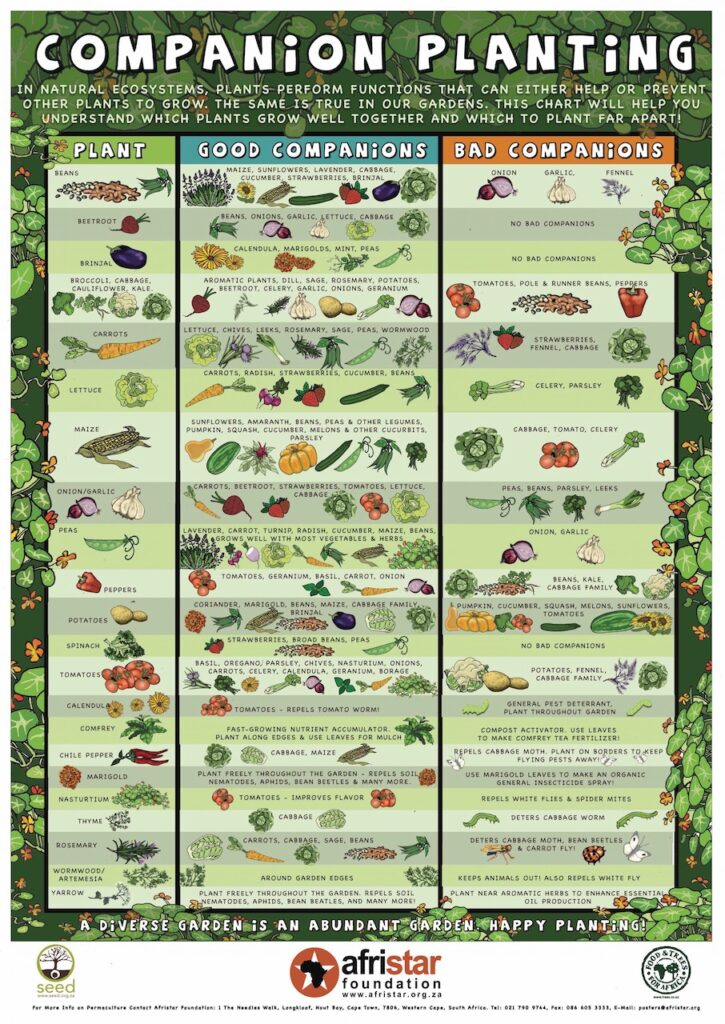

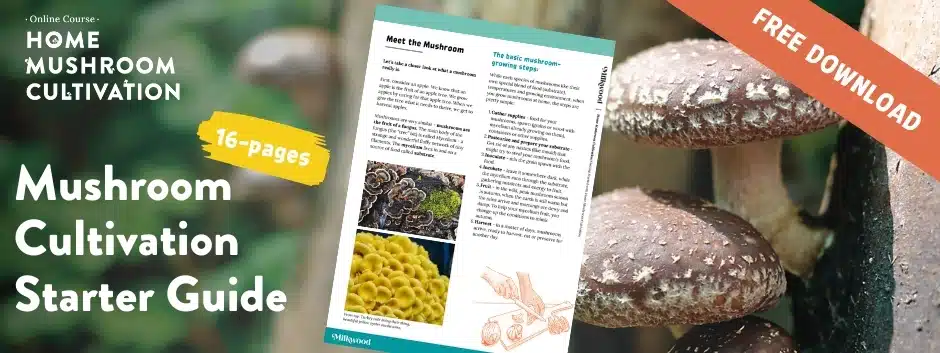
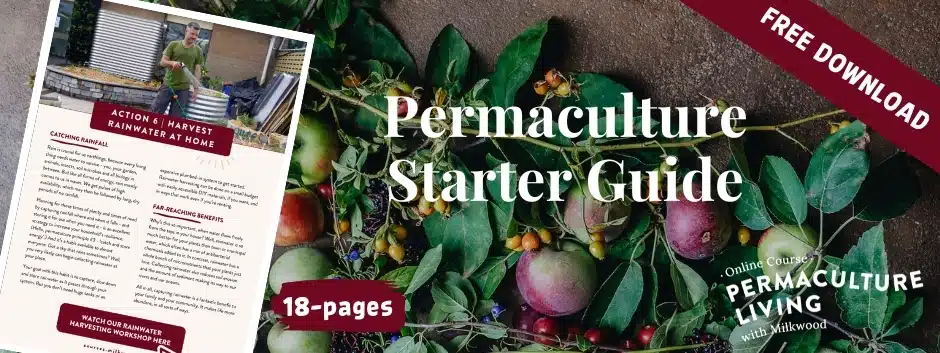
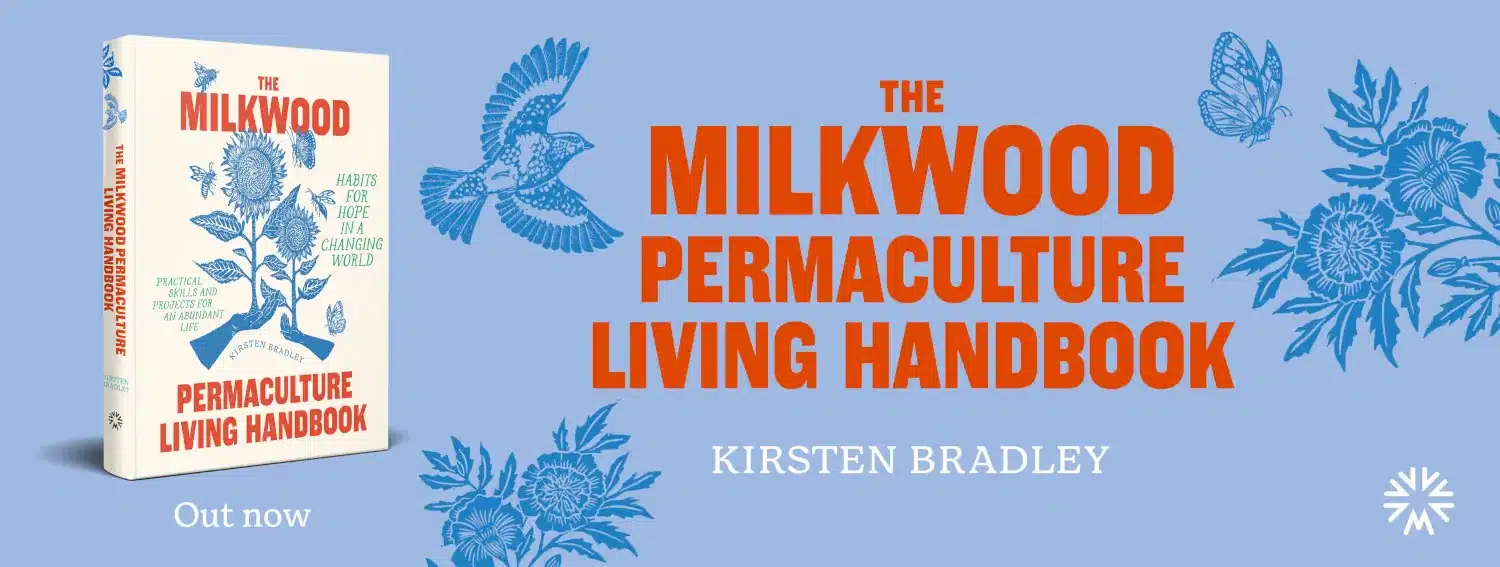
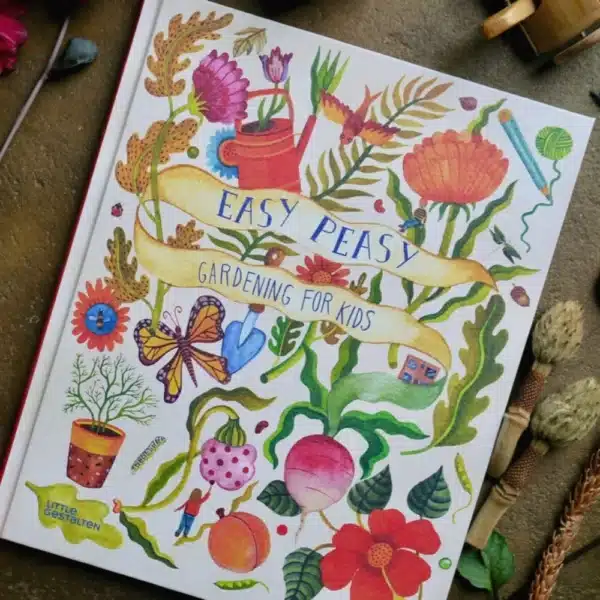
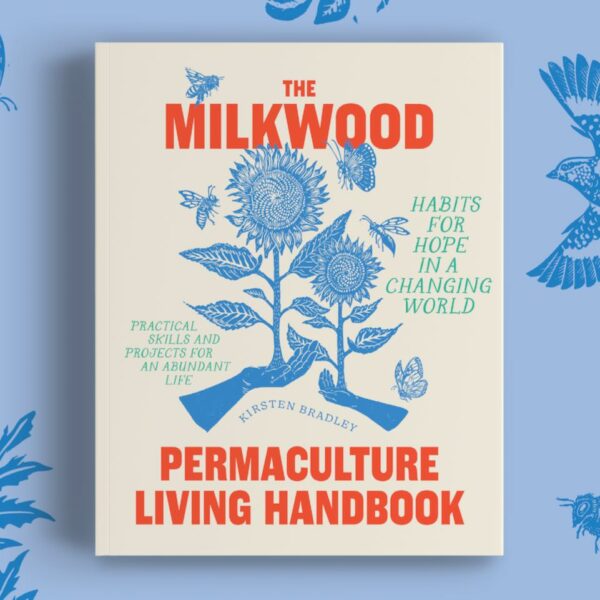







That was one of the best articles I’ve been looking for! Thank you so much for sharing this abundance information, it gives me more motivation to try and observe my garden!x
excellent! So happy to help 🙂
Thank you for sharing this very important companion planting guide. I will try them this year, although I had used some of the plants in my vegetables beds.
sounds great 🙂